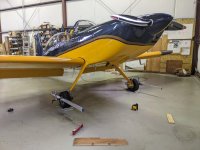Hi, Moe,
Mel beat me to it

, but here is an expanded explanation:
You are entirely correct that in racing cars, toe out is desirable to make the turn in more aggressive. The reason for this is that at turn initiation, there is little weight transfer until the entire chassis rotates to give the rear tires the angle of attack (known as "slip angle" in tires), they need to create a lateral force. Toe out makes the inside front grab more aggressively on turn entry, speeding up the rotation of the chassis. However, the opposite is true with a taildragger aircraft: Mainwheel toe OUT creates a stabilizing force.
First, let me explain my background to give a bit more credibility: I am a Mechanical Engineer, with 35 years' experience in engineering and driving of open wheel (Formula 2000 and others) cars, reasonably successfully. Chassis setup was my specialty. Now, why toe out?
As we all know, the tailwheel aircraft is inherently unstable on the ground because the CG is aft of the main wheels. If both wheels have toe in, both wheels will be creating a force towards the centerline of the aircraft when rolling straight ahead. When the aircraft diverges from a straight path (swerves), even slightly, weight is transferred from the inside wheel to the outside wheel, thus the outside wheel will have a greater lateral thrust capability and the inside wheel will have less lateral thrust capability - the net is an increase in force in the direction of the swerve, increasing the swerve rate, and requiring a very authoritative rudder response from the pilot.
Conversely, if the wheels have toe out, both wheels will be creating a force outward, away from the centerline of the aircraft when rolling straight ahead. When the aircraft diverges from a straight path (swerves), weight is transferred from the inside wheel to the outside wheel. Again, the inside wheel loses some lateral force, while the outside gains some lateral force. But here's the key: weight and lateral force capability is still transferred, but the toe out of the outside wheel helps to "steer" the airplane straight.
Note that the airplane is still unstable, but less so with toe out. In my own case, my RV8 had an initial toe IN of 1.25 degrees. I found the airplane to be controllable, but "nervous." Using the VAN's supplied shims, I set toe OUT 0.25 degrees. The "nervous" feeling was greatly reduced.
Now, look at the same analysis for a tricycle aircraft: Toe IN is stabilizing as the CG is ahead of the main landing gear. Think about it…..
As noted above, when transitioning from tail up to tail down on landing, the camber of the wheels will move the wheels towards toe in. For the typical10 degree nose up three-point attitude this will translate to approximately (10/90 x camber angle) or .11 degrees per degree of caster. This argues for even MORE toe out to retain relative stability in the 3-point attitude. At my next condition inspection, I'll increase the toe out to see if this can be documented.
As an aside, by changing the toe in I increased my tire life from 240 landings to 600 landings, and the wear is much more even (both sets of tires were Goodyear Flight Eagle III)





